12 Disturbing Secrets People Realized Only Later On

So you’re going on a journey to a black hole? You will need a lot of provisions because the nearest black hole is 1,011 light-years away. This black pearl was found in the solar system called HR 6819. It was hidden in orbit with two other stars, which you can see with the human eye.
Scientists have been studying this system since the 80s, but this winter, it revealed its main secret. This particular black hole is considered relatively small. But despite this, its mass is four times bigger than our Sun, and it’s 2,500 light-years closer to Earth than the next nearest black hole.
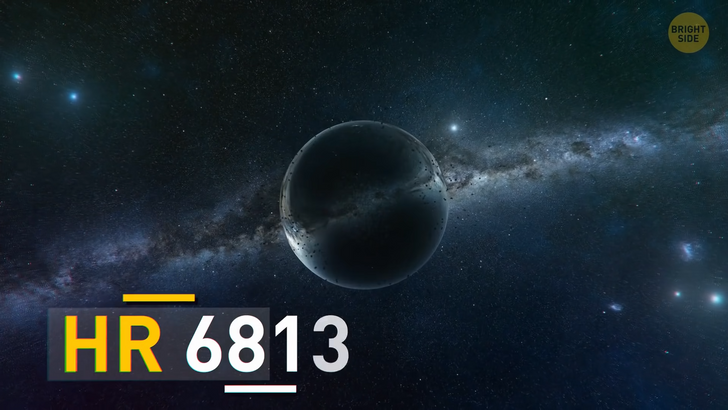
But don’t worry. For people, the distance of 1,000 light-years is unreachable. For example, if we were to make a model where the Earth’s distance to the Sun was only .05 inches, [0.12 cm] you would have to travel about 4 miles[6.4 km] to get to this black hole. But our galaxy, the Milky Way, is about 100,000 light-years wide. So the distance of 1,011 light-years doesn’t seem that long in comparison.
But before you jump inside this black giant, let me try to discourage you. A black hole is a place in space-time where nothing can leave its orbit. No particles, electromagnetic radiation, or even photons of light can escape from a black hole. So, you should understand that a journey to such a dangerous object as a black hole is a one-way ticket.
And the way black holes are born is incredible. When a star runs out of fuel, the star collapses under its own weight and becomes a black hole, like the supermassive black hole in the Messier 87 galaxy. Its mass is 7 billion times bigger than the Sun, and it was discovered by the Event Horizon Telescope in April 2019.
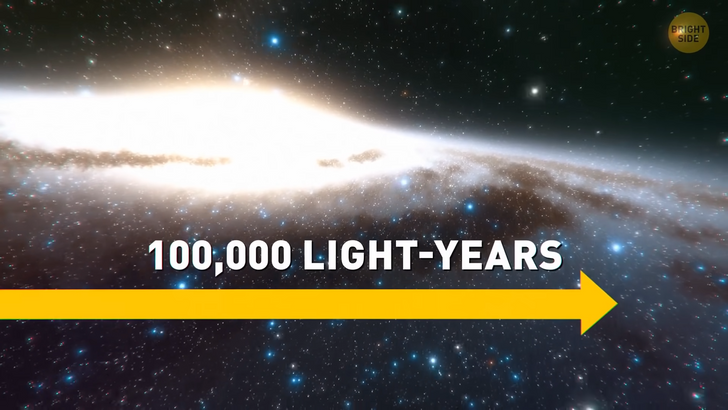
Okay, good. I see you’ve already bought a ticket for a faster-than-light spaceship. Since there’re no refunds, and you don’t want to lose the money, it’s time to get ready for the trip! Oh, feel free to leave your luggage at home. 3, 2, 1, off you go! You’re leaving Earth’s orbit, saying goodbye to the moon, and don’t forget to cheer up Pluto by saying it is big enough to be a planet. Then you pass the highway of dark space, and here’s your stop — the black hole. Put on your suit, because you’re going into outer space.
The first thing you see is the event horizon. The gravitational field of a black hole bends the light around its edges, so the event horizon is like a croissant for the observer. Once you reach the event horizon, [danger!] though, you won’t be able to get back out.
You may also notice that there’s some kind of chaos in this ring. Some lights move in different directions. This happens because you get a mirror effect. But we still don’t know what’s inside the black hole. So you decide to send in a drone first.
The gravity field of the black hole quickly draws in your metal buddy. As soon as he enters the event horizon, his body begins to change its shape. It becomes elongated like a strand of spaghetti. And the closer it gets to the center of the black hole, the longer it becomes. You also notice the drone has slowed its movement and on gradually approaches the black hole center.
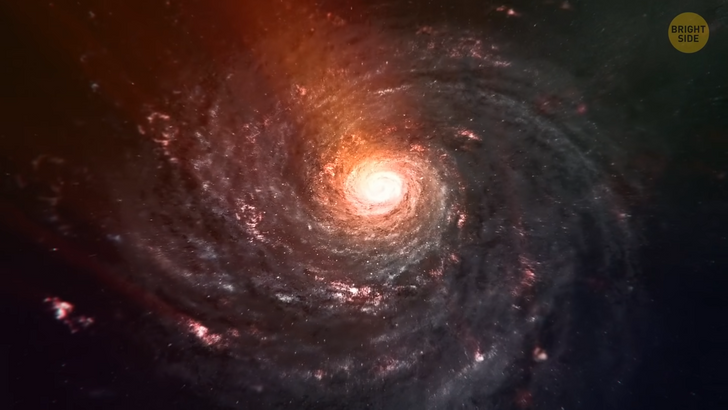
This is another effect of this space monster. The black hole’s vast mass curves not only space but also time. If you hang one watch next to a black hole and another on the wall in your bedroom, you will see that in the first watch, the second hand has barely moved while a whole day has passed on Earth. And the more massive the black hole, the stronger the effect of slowing time. Theoretically, if you have a spaceship that can overcome the gravity of a black hole, you can fly to it and wait a few seconds. During this time, your friends on Earth would live a whole life!
Hmm. The flashlight on the head of your drone has turned red. This color change has happened for the same reason. The clocks that are deeper in a gravitational well tick slower when observed from outside. This also affects the photon’s wavelength. We see red light because it has the longest wavelength of any color in the visible spectrum.
All of these things actually happened to the drone in a split second. But it seemed slow to you because of the time warp. All right, it’s time to enter the black hole yourself! The final preparation is your suit that will protect you from Hawking radiation. This radiation is created by black holes due to quantum effects near the event horizon. Hawking radiation reduces the weight of the black hole.
So, if the black hole doesn’t absorb more mass from nearby objects, it becomes smaller and then simply disappears. Oh yes, the black holes are also mortal. But Hawking radiation can turn you into ash, and you’d lose the chance to see the black hole from the inside.
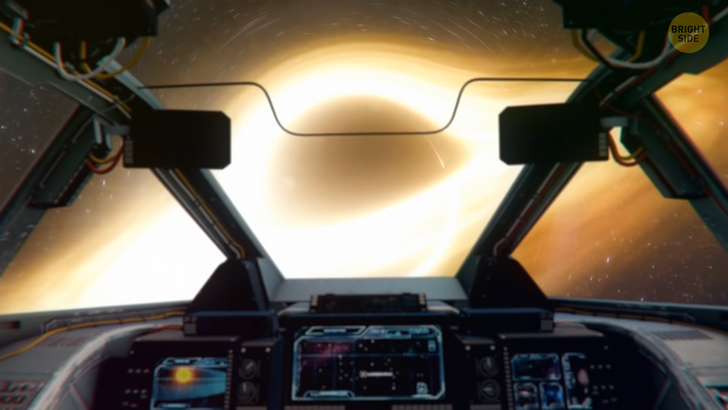
Okay, now let’s do what you traveled 1,011 light-years to do. One big jump, and you are caught in the gravity field of the black hole. This is the point of no return. But your distance allows you to set a stable orbit so that you can spin around the black hole like the moon around the Earth.
A little higher, and you will be thrown into infinity. A little lower, and you will be dragged into the black hole. So theoretically, planets could exist at this distance. And even inhabited, if there were the necessary conditions. A couple of minutes later, and you are approaching the event horizon. Oh, look down. Your body is so long. You are now spaghetti yourself!
Look around you. The stars are turning blue. This is called gravitational blueshift. As you fall into a black hole, its gravitational field pulls the photons of light down, giving them energy. Their wavelengths are getting shorter, so the red photons change into blue, and everything starts to look blue.
Now you are right outside the event horizon, and the only thing you can see is a round blue beam of light above you. But soon you will stop seeing even that.

So, you’ve survived the strong gravitational field of a black hole, and the Hawking radiation didn’t burn you to ash. You are now in the heart of the most mysterious object in the universe. You have front row seats, but the view is not that impressive. This is the darkest place you have ever been to. Even the usual laws of physics just stop working here. Theoretically, time goes so slowly here that your home planet could no longer exist. And a new black hole could appear in place of our Sun. But you will live exactly as long as there’s enough oxygen in your suit.
But what if this cosmic object is actually a wormhole that leads to another place in the universe? This is a popular theory, but scientists still can’t confirm it. But, if it is true, then after a while, you will see a blue light again. Now you will experience the same fall only in reverse. Once you leave the singularity, which means the black hole’s heart, you will be in the event horizon. The light from the stars gradually changes from blue to red. You can feel the shaking and warmth from the Hawking radiation. But then you are thrown into outer space, perhaps in some faraway galaxy.
No one knows what will happen next. Are you in contact with an unknown life form? Or will the conditions there be intolerable for a human being? Or maybe you will go not to another place in space, but to a parallel universe. This theory also exists. According to it, black holes are portals to other dimensions. Simply put, there are endless copies of our universe. Every time you were faced with a choice, your twin from another universe chose something else. But let’s leave that to fantastic movies.
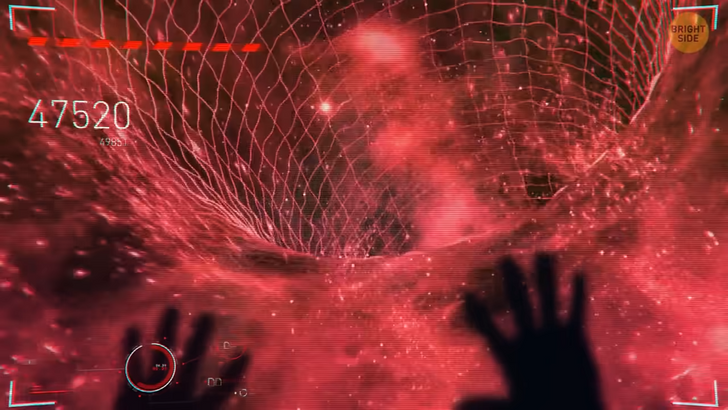
Right now, the journey into a black hole is merely impossible for humanity. We can’t even reach the nearest one. But one day, we will learn more about these space objects’ nature, and maybe this knowledge will push humanity forward and make us a multi-galactic civilization.











